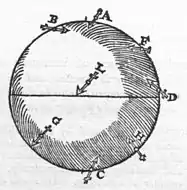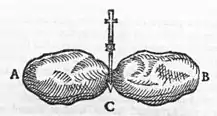CHAP. XVII.
On the Use and Excellence of Versoria: and how iron
versoria used as pointers in sun-dials, and the fine needles
of the mariners' compass, are to be rubbed, that
they may acquire stronger verticity.



The page and line references given in these notes are in all cases first to the Latin edition of 1600, and secondly to the English edition of 1900.
216 ^ Page 147, line 27. Page 147, line 29. ex optimo aciario.—Gilbert recommended that the compass-needle should be of the best steel. Though the distinction between iron and steel was not at this time well established, there is no reason to doubt that by aciarium was meant edge-steel as used for blades. Barlowe, in his Magneticall Advertisements (Lond., 1616), p. 66, gives minute instructions for the fashioning of the compass-needle. He gives the preference to a pointed oval form, and describes how the steel must be hardened by heating to whiteness and quenching in water, so that it is "brickle in a manner as glass it selfe," and then be tempered by reheating it over a bar of red hot iron until it is let down to a blue tint. Savery (Philos. Trans., 1729) appears to have been the first to make a systematic examination of the magnetic differences between hard steel and soft iron.
Instructions for touching the needle are given in the Arte de Nauegar of Pedro de Medina (Valladolid, 1545, lib. vi., cap. 1).
217 ^ Page 149, line 8. Page 149, line 9. per multa sæcula.—Compare Porta's assertion (p. 208, English edition) "iron once rubbed will hold the vertue a hundred years." Clearly not a matter within the actual experience of either Porta or Gilbert.